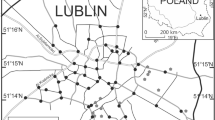Abstract
The relative importance of local and regional sources of lead and associated elements in fine and coarse aerosol particles of an urban atmosphere was assessed by means of a two-day study, July 20 and 30, 1980 in Beijing, China. Five near-ground locations were selected for aerosol sampling by cascade impactors and elemental analysis by proton induced X-ray emission (PIXE): the imperial palace courtyard, a park, near two streets, and a mid-street traffic island. These sites, ranked in order of increasing traffic intensity and fugitive surface dust, showed that concentrations of major dust constitutents, represented by coarse particle (>2 μm diameter) Si, Al, and Ca, increased correspondingly. Pb, as well as Zn, As, and Cu, were present mainly in fine (<2 μm) particles; their concentrations were unrelated to traffic, indicating they resulted mainly from regional combustion or other sources. However, these elements also were present in coarse particles at concentrations that varied with the major dust elements and were relatively enriched, compared to average earth crust rock material, by factors of more than 100 (Pb), 50 (Zn), and 10 (Cu). Nonurban Beijing shows much smaller coarse aerosol enrichments of Pb, Zn, and Cu, indicating urban contamination of surface dust. Published data from St. Louis, USA show both fine and coarse aerosol Pb and Zn. Compared with Beijing, fine and coarse concentrations in St. Louis are similar for Pb, but lower for Zn, Ca, and Fe. Both Pb and Zn are enriched relative to earth crust composition to a greater degree in St. Louis than Beijing in both fine and coarse particle size ranges. The results suggest that heavy metals from combustion occur in the air as fine particles and, after deposition on the surface, as reentrained coarse particles of fugitive dust. Both many contribute to human exposures of these heavy metals.
Similar content being viewed by others
References
J. W. Winchester, W. X. Lü, L. X. Ren, M. X. Wang, and W. Maenhaut,Atmos. Environ. 15, 933 (1981).
B. Mason,Principles of Geochemistry, 3rd edition, Wiley, New York, 1966.
J. O. Pilotte, J. W. Winchester, and J. W. Nelson,J. Applied Meterol. 17, 627 (1978).
J. W. Winchester, D. L. Meinert, J. W. Nelson, T. B. Johansson, R. E. Van Grieken, C. Orsini, H. C. Kaufmann, and R. Akselsson. Trace Metals in the St. Louis Aerosol, inProceedings of the 2nd International Conference on Nuclear Methods in Environmental Research, Columbia, MO USERDA CONF 740701, 1974, pp. 385–394.
R. Akselsson, C. Orsini, D. L. Meinert, T. B. Johansson, R. E. Van Grieken, H. C. Kaufmann, K. R. Chapman, J. W. Nelson and J. W. Winchester. Applications of Proton-Induced X-Ray Emission Analysis to the St. Louis Regional Air Pollution Study, inAdvances in X-Ray Analysis, Vol. 18, Plenum, New York, 1975, pp. 588–597.
C. Q. Orsini, H. C. Kaufmann, K. R. Akselsson, J. W. Winchester, and J. W. Nelson,Nucl. Instr. Meth. 142, 91 (1977).
Author information
Authors and Affiliations
Rights and permissions
About this article
Cite this article
Bi, Mt., Chen, J., Yao, Rk. et al. Aerosol lead and associated elements in Beijing, China. Biol Trace Elem Res 6, 19–29 (1984). https://doi.org/10.1007/BF02918318
Received:
Accepted:
Issue Date:
DOI: https://doi.org/10.1007/BF02918318




